Life Cycle Assessment of Road Pavements That Incorporate Waste Reuse: A Systematic Review and Guidelines Proposal
Abstract
:1. Introduction
2. Methodology
2.1. Selection of Bibliographic Portfolios
2.2. Bibliometric Analysis
2.3. Systematic Analysis
3. Results and Discussion
3.1. Selection of Documents
3.2. Bibliometric Analysis
3.3. Systematic Analysis
3.3.1. Type of Waste Incorporated
3.3.2. Application to Paved Roads
- Surfacing: the outermost layer that absorbs the stresses caused by traffic; its purpose is to protect and waterproof the other layers, resist skidding, and offer a smooth, uniform layer that provides comfort to those traveling on it.
- Base: resists the deformations and stresses transmitted by the surfacing layer, distributing these stresses evenly over the inner layers. It also allows water to percolate in a controlled manner by means of drains.
- Subbase: also transmits the stresses of the upper layers to the lower ones. It is usually made up of less noble soil, so its main function is to reduce the thickness of the base, thus lowering the cost of base construction.
- Subbase reinforcement: its function is to improve the characteristics of the subbase to support the above layers and to stabilize the subbase layer.
- Subgrade: the foundation soil that will support the paved road. This soil is generally composed of material from the area in which the road is built.
3.3.3. First Phase of Life Cycle Assessment: Goal, Scope, Functional Unit, and System Boundaries
3.3.4. Life Cycle Inventory Analysis
3.3.5. Impact Assessment Methods and Categories
3.3.6. Waste Impact Allocation
3.3.7. Sensitivity and Uncertainty Analysis
3.4. Discussion
4. Guidelines for Future Work
4.1. Defining the Objective and Scope
4.2. Life Cycle Inventory
4.3. Impact Methodology
4.4. Interpretation
5. Conclusions
- There has been an increase in research over recent years regarding the application of LCA to paved roads.
- Most of these studies have looked at the application of RAP, and there is ample opportunity to carry out research into various other types of waste. The studies primarily focused on the top layer of the paved road, asphalt concrete, which was evaluated in more than 75% of the studies.
- There are several information gaps in the studies found, such as the absence of a clearly defined objective, inadequate disclosure of software version and database information, insufficient indication of methods applied, a lack of information about follow-up procedures, and an absence of guidance regarding waste allocation. Addressing these gaps has the potential to enhance the tool’s applicability within this research area.
Author Contributions
Funding
Data Availability Statement
Acknowledgments
Conflicts of Interest
References
- Abrelpe. Panorama dos Resíduos Sólidos No Brasil 2022; 1 Dez: São Paulo, Brazil, 2022. [Google Scholar]
- UNEP. The 10YFP Programme on Sustainable Buildings and Construction. Available online: www.unep.org/10yfp (accessed on 10 October 2022).
- Wieser, A.A.; Scherz, M.; Passer, A.; Kreiner, H. Challenges of a healthy built environment: Air pollution in construction industry. Sustainability 2021, 13, 10469. [Google Scholar] [CrossRef]
- World Business Council for Sustainable Development. Cement Sustainability Iniciative: Getting the Numbers Right Project; World Business Council for Sustainable Development: Geneva, Switzerland, 2014. [Google Scholar]
- Sereewatthanawut, I.; Prasittisopin, L. Environmental evaluation of pavement system incorporating recycled concrete aggregate. Int. J. Pavement Res. Technol. 2020, 13, 455–465. [Google Scholar] [CrossRef]
- Bayram, B.; Greiff, K. Life cycle assessment on construction and demolition waste recycling: A systematic review analyzing three important quality aspects. Int. J. Life Cycle Assess. 2023, 28, 967–989. [Google Scholar] [CrossRef]
- Li, J.; Xiao, F.; Zhang, L.; Amirkhanian, S.N. Life cycle assessment and life cycle cost analysis of recycled solid waste materials in highway pavement: A review. J. Clean. Prod. 2019, 233, 1182–1206. [Google Scholar] [CrossRef]
- Bernucci, L.B.; Motta, L.M.; Ceratti, J.A.; Soares, J.B. Pavimentação Asfáltica: Formação Básica Para Engenheiros; ABEDA: Rio de Janeiro, Brazil, 2008. [Google Scholar]
- NBR ISO 14040; Gestão Ambiental—Avaliação do Ciclo de Vida—Princípio e Estrutura. Associação Brasileira de Normas Técnicas: Rio de Janeiro, Brazil, 2009.
- NBR ISO 14044; Gestão Ambiental—Avaliação do Ciclo de Vida—Requisitos e Orientações. Associação Brasileira de Normas Técnicas: Rio de Janeiro, Brazil, 2009.
- Mikhailenko, P.; Piao, P.; Poulikakos, L.D. Electric arc furnace slag as aggregates in semi-dense asphalt. Case Stud. Constr. Mater. 2023, 18, e02049. [Google Scholar] [CrossRef]
- Balaguera, A.; Carvajal, G.I.; Arias, Y.P.; Albertí, J.; Fullana-i-Palmer, P. Technical feasibility and life cycle assessment of an industrial waste as stabilizing product for unpaved roads, and influence of packaging. Sci. Total Environ. 2019, 651, 1272–1282. [Google Scholar] [CrossRef]
- Pantini, S.; Borghi, G.; Rigamonti, L. Towards resource-efficient management of asphalt waste in Lombardy region (Italy): Identification of effective strategies based on the LCA methodology. Waste Manag. 2018, 80, 423–434. [Google Scholar] [CrossRef]
- Lima, M.S.S.; Makoundou, C.; Sangiorgi, C.; Gschösser, F. Life cycle assessment of innovative asphalt mixtures made with crumb rubber for impact-absorbing pavements. Sustainability 2022, 14, 14798. [Google Scholar] [CrossRef]
- Rosado, L.P.; Vitale, P.; Penteado, C.S.G.; Arena, U. Life cycle assessment of natural and mixed recycled aggregate production in Brazil. J. Clean. Prod. 2017, 151, 634–642. [Google Scholar] [CrossRef]
- Tushar, Q.; Salehi, S.; Santos, J.; Zhang, G.; Bhuiyan, M.A.; Arashpour, M.; Giustozzi, F. Application of recycled crushed glass in road pavements and pipeline bedding: An integrated environmental evaluation using LCA. Sci. Total Environ. 2023, 881, 163488. [Google Scholar] [CrossRef]
- Mladenovič, A.; Turk, J.; Kovač, J.; Mauko, A.; Cotič, Z. Environmental evaluation of two scenarios for the selection of materials for asphalt wearing courses. J. Clean. Prod. 2015, 87, 683–691. [Google Scholar] [CrossRef]
- Riekstins, A.; Haritonovs, V.; Straupe, V. Life cycle cost analysis and life cycle assessment for road pavement materials and reconstruction technologies. Balt. J. Road Bridge Eng. 2020, 15, 118–135. [Google Scholar] [CrossRef]
- Perucca, M.; Capuano, L.; Magatti, G.; Rosa, F.; Mantecca, P. Environmental performance of road asphalts modified with end-of-life hard plastics and graphene: Strategies for improving sustainability. Processes 2022, 10, 2151. [Google Scholar] [CrossRef]
- Landi, D.; Gigli, S.; Germani, M.; Marconi, M. Investigating the feasibility of a reuse scenario for textile fibres recovered from end-of-life tyres. Waste Manag. 2018, 75, 187–204. [Google Scholar] [CrossRef]
- Abdalla, A.; Faheem, A.F.; Walters, E. Life cycle assessment of eco-friendly asphalt pavement involving multi-recycled materials: A comparative study. J. Clean. Prod. 2022, 362, 132471. [Google Scholar] [CrossRef]
- Yang, R.; Kang, S.; Ozer, H.; Al-Qadi, I.L. Environmental and economic analyses of recycled asphalt concrete mixtures based on material production and potential performance. Resour. Conserv. Recycl. 2015, 104, 141–151. [Google Scholar] [CrossRef]
- Zhang, Y.; Gong, H.; Jiang, X.; Lv, X.; Xiao, R.; Huang, B. Environmental impact assessment of pavement road bases with reuse and recycling strategies: A comparative study on geopolymer stabilized macadam and conventional alternatives. Transp. Res. D Transp. Environ. 2021, 93, 102749. [Google Scholar] [CrossRef]
- Bamigboye, G.O.; Bassey, D.E.; Olukanni, D.O.; Ngene, B.U.; Adegoke, D.; Odetoyan, A.O.; Kareem, M.A.; Enabulele, D.O.; Nworgu, A.T. Waste materials in highway applications: An overview on generation and utilization implications on sustainability. J. Clean. Prod. 2021, 283, 124581. [Google Scholar] [CrossRef]
- Alaloul, W.S.; Altaf, M.; Musarat, M.A.; Javed, M.F.; Mosavi, A. Systematic review of life cycle assessment and life cycle cost analysis for pavement and a case study. Sustainability 2021, 13, 4377. [Google Scholar] [CrossRef]
- Pouranian, M.R.; Shishehbor, M. Sustainability Assessment of Green Asphalt Mixtures: A Review. Environments 2019, 6, 73. [Google Scholar] [CrossRef]
- Liu, N.; Wang, Y.; Bai, Q.; Liu, Y.; Wang, P.S.; Xue, S.; Yu, Q.; Li, Q. Road life-cycle carbon dioxide emissions and emission reduction technologies: A review. J. Traffic Transp. Eng. 2022, 9, 532–555. [Google Scholar] [CrossRef]
- Wang, T.; Xiao, F.; Zhu, X.; Huang, B.; Wang, J.; Amirkhanian, S. Energy consumption and environmental impact of rubberized asphalt pavement. J. Clean. Prod. 2018, 180, 139–158. [Google Scholar] [CrossRef]
- Balaguera, A.; Carvajal, G.I.; Albertí, J.; Fullana-i-Palmer, P. Life cycle assessment of road construction alternative materials: A literature review. Resour. Conserv. Recycl. 2018, 132, 37–48. [Google Scholar] [CrossRef]
- Vilela, L.O. Aplicação do ProKnow-C para seleção de um portifólio bibliográfico e análise bibliométrica sobre avaliação de desempenho da gestão do conhecimento. Rev. Gest. Ind. 2012, 8, 76–92. [Google Scholar] [CrossRef]
- Rebello, T.A.; Roque, R.P.; Gonçalves, R.F.; Calmon, J.L.; Queiroz, L.M. Life cycle assessment of urban wastewater treatment plants: A critical analysis and guideline proposal. Water Sci. Technol. 2020, 83, 501–514. [Google Scholar] [CrossRef]
- Martin, M.; Svensson, N.; Eklund, M. Who gets the benefits? An approach for assessing the environmental performance of industrial symbiosis. J. Clean. Prod. 2015, 98, 263–271. [Google Scholar] [CrossRef]
- Zheng, X.; Easa, S.M.; Yang, Z.; Ji, T.; Jiang, Z. Life-cycle sustainability assessment of pavement maintenance alternatives: Methodology and case study. J. Clean. Prod. 2019, 213, 659–672. [Google Scholar] [CrossRef]
- Zhang, J.; Ding, L.; Li, F.; Peng, J. Recycled aggregates from construction and demolition wastes as alternative filling materials for highway subgrades in China. J. Clean. Prod. 2020, 255, 120223. [Google Scholar] [CrossRef]
- Zanetti, M.C.; Farina, A. Life cycle risk assessment applied to gaseous emissions from crumb rubber asphalt pavement construction. Sustainability 2022, 14, 5716. [Google Scholar] [CrossRef]
- Zhang, J.; Guo, C.; Chen, T.; Zhang, W.; Yao, K.; Fan, C.; Liang, M.; Guo, C.; Yao, Z. Evaluation on the mechanical performance of recycled asphalt mixtures incorporated with high percentage of RAP and self-developed rejuvenators. Constr. Build. Mater. 2021, 269, 121337. [Google Scholar] [CrossRef]
- Allegrini, E.; Vadenbo, C.; Boldrin, A.; Astrup, T.F. Life cycle assessment of resource recovery from municipal solid waste incineration bottom ash. J. Environ. Manag. 2015, 151, 132–143. [Google Scholar] [CrossRef] [PubMed]
- Deviatkin, I.; Havukainen, J.; Horttanainen, M. Comparative life cycle assessment of thermal residue recycling on a regional scale: A case study of South-East Finland. J. Clean. Prod. 2017, 149, 275–289. [Google Scholar] [CrossRef]
- Di Gianfilippo, M.; Costa, G.; Pantini, S.; Allegrini, E.; Lombardi, F.; Astrup, T.F. LCA of management strategies for RDF incineration and gasification bottom ash based on experimental leaching data. Waste Manag. 2016, 47, 285–298. [Google Scholar] [CrossRef] [PubMed]
- Movilla-Quesada, D.; Lagos-Varas, M.; Raposeiras, A.C.; Muñoz-Cáceres, O.; Andrés-Valeri, V.C.; Aguilar-Vidal, C. Analysis of greenhouse gas emissions and the environmental impact of the production of asphalt mixes modified with recycled materials. Sustainability 2021, 13, 8081. [Google Scholar] [CrossRef]
- Schwab, O.; Bayer, P.; Juraske, R.; Verones, F.; Hellweg, S. Beyond the material grave: Life cycle impact assessment of leaching from secondary materials in road and earth constructions. Waste Manag. 2014, 34, 1884–1896. [Google Scholar] [CrossRef]
- Ferreira, V.J.; Vilaplana, A.S.-D.-G.; García-Armingol, T.; Aranda-Usón, A.; Lausín-González, C.; López-Sabirón, A.M.; Ferreira, G. Evaluation of the steel slag incorporation as coarse aggregate for road construction: Technical requirements and environmental impact assessment. J. Clean. Prod. 2016, 130, 175–186. [Google Scholar] [CrossRef]
- Díaz-Piloneta, M.; Terrados-Cristos, M.; Álvarez-Cabal, J.V.; Vergara-González, E. Comprehensive analysis of steel slag as aggregate for road construction: Experimental testing and environmental impact assessment. Materials 2021, 14, 3587. [Google Scholar] [CrossRef]
- Nizamuddin, S.; Jamal, M.; Santos, J.; Giustozzi, F. Recycling of low-value packaging films in bitumen blends: A grey-based multi criteria decision making approach considering a set of laboratory performance and environmental impact indicators. Sci. Total Environ. 2021, 778, 146187. [Google Scholar] [CrossRef]
- Veropalumbo, R.; Oreto, C.; Viscione, N.; Biancardo, S.A.; Russo, F. Environmental assessment of asphalt mastics containing plastic bottles and jet grouting waste. Environ. Impact Assess. Rev. 2022, 93, 106736. [Google Scholar] [CrossRef]
- Oreto, C.; Veropalumbo, R.; Viscione, N.; Biancardo, S.A.; Russo, F. Investigating the environmental impacts and engineering performance of road asphalt pavement mixtures made up of jet grouting waste and reclaimed asphalt pavement. Environ. Res. 2021, 198, 111277. [Google Scholar] [CrossRef]
- Praticò, F.G.; Giunta, M.; Mistretta, M.; Gulotta, T.M. Energy and environmental life cycle assessment of sustainable pavement materials and technologies for urban roads. Sustainability 2020, 12, 704. [Google Scholar] [CrossRef]
- Santos, J.; Pham, A.; Stasinopoulos, P.; Giustozzi, F. Recycling waste plastics in roads: A life-cycle assessment study using primary data. Sci. Total Environ. 2021, 751, 141842. [Google Scholar] [CrossRef] [PubMed]
- Vega, D.L.; Gilberto, M.A.; dos Santos, J.M.O. Life cycle assessment of warm mix asphalt with recycled concrete aggregate. IOP Conf. Ser. Mater. Sci. Eng. 2019, 603, 052016. [Google Scholar] [CrossRef]
- Veropalumbo, R.; Oreto, C.; Viscione, N.; Russo, F. Investigating the environmental and mechanical properties of sustainable asphalt mastic solutions for road flexible pavements. Transp. Res. Procedia 2023, 69, 225–232. [Google Scholar] [CrossRef]
- Polo-Mendoza, R.; Peñabaena-Niebles, R.; Giustozzi, F.; Martinez-Arguelles, G. Eco-friendly design of Warm mix asphalt (WMA) with recycled concrete aggregate (RCA): A case study from a developing country. Constr. Build. Mater. 2022, 326, 126890. [Google Scholar] [CrossRef]
- Huang, Y.; Wolfram, P.; Miller, R.; Azarijafari, H.; Guo, F.; An, K.; Li, J.; Hertwich, E.; Gregory, J.; Wang, C. Mitigating life cycle GHG emissions of roads to be built through 2030: Case study of a Chinese province. J. Environ. Manag. 2022, 319, 115512. [Google Scholar] [CrossRef]
- Gu, F.; Ma, W.; West, R.C.; Taylor, A.J.; Zhang, Y. Structural performance and sustainability assessment of cold central-plant and in-place recycled asphalt pavements: A case study. J. Clean. Prod. 2019, 208, 1513–1523. [Google Scholar] [CrossRef]
- Cao, R.; Leng, Z.; Hsu, S.-C. Comparative eco-efficiency analysis on asphalt pavement rehabilitation alternatives: Hot in-place recycling and milling-and-filling. J. Clean. Prod. 2019, 210, 1385–1395. [Google Scholar] [CrossRef]
- Yao, L.; Leng, Z.; Lan, J.; Chen, R.; Jiang, J. Environmental and economic assessment of collective recycling waste plastic and reclaimed asphalt pavement into pavement construction: A case study in Hong Kong. J. Clean. Prod. 2022, 336, 130405. [Google Scholar] [CrossRef]
- Poulikakos, L.D.; Kakar, M.R.; Piao, Z. Urban mining for low-noise urban roads towards more sustainability in the urban environment. Road Mater. Pavement Des. 2023, 24, 309–320. [Google Scholar] [CrossRef]
- Hasan, U.; Whyte, A.; Al Jassmi, H. Life cycle assessment of roadworks in United Arab Emirates: Recycled construction waste, reclaimed asphalt pavement, warm-mix asphalt and blast furnace slag use against traditional approach. J. Clean. Prod. 2020, 257, 120531. [Google Scholar] [CrossRef]
- Lima, M.S.S.; Hajibabaei, M.; Hesarkazzazi, S.; Sitzenfrei, R.; Buttgereit, A.; Queiroz, C.; Haritonovs, V.; Gschösser, F. Determining the Environmental Potentials of Urban Pavements by Applying the Cradle-to-Cradle LCA Approach for a Road Network of a Midscale German City. Sustainability 2021, 13, 12487. [Google Scholar] [CrossRef]
- Sianipar, C.P.M.; Dowaki, K. Eco-burden in pavement maintenance: Effects from excess traffic growth and overload. Sustain. Cities Soc. 2014, 12, 31–45. [Google Scholar] [CrossRef]
- Araújo, J.P.C.; Oliveira, J.R.M.; Silva, H.M.R.D. The importance of the use phase on the LCA of environmentally friendly solutions for asphalt road pavements. Transp. Res. D Transp. Environ. 2014, 32, 97–110. [Google Scholar] [CrossRef]
- Turk, J.; Pranjić, A.M.; Mladenovič, A.; Cotič, Z.; Jurjavčič, P. Environmental comparison of two alternative road pavement rehabilitation techniques: Cold-in-place-recycling versus traditional reconstruction. J. Clean. Prod. 2016, 121, 45–55. [Google Scholar] [CrossRef]
- Hong, F.; Prozzi, J.A. Evaluation of recycled asphalt pavement using economic, environmental, and energy metrics based on long-term pavement performance sections. Road Mater. Pavement Des. 2018, 19, 1816–1831. [Google Scholar] [CrossRef]
- Wang, F.; Hoff, I.; Yang, F.; Wu, S.; Xie, J.; Li, N.; Zhang, L. Comparative assessments for environmental impacts from three advanced asphalt pavement construction cases. J. Clean. Prod. 2021, 297, 126659. [Google Scholar] [CrossRef]
- Jolliet, O.; Saade-Sbeih, M.; Shaked, S.; Jolliet, A.; Crettaz, P. Environmental Life Cycle Assessment, 1st ed.; CRC Press: Boca Raton, FL, USA, 2015. [Google Scholar] [CrossRef]
- Piao, Z.; Bueno, M.; Poulikakos, L.D.; Hellweg, S. Life cycle assessment of rubberized semi-dense asphalt pavements; A hybrid comparative approach. Resour. Conserv. Recycl. 2022, 176, 105950. [Google Scholar] [CrossRef]
- Giani, M.I.; Dotelli, G.; Brandini, N.; Zampori, L. Comparative life cycle assessment of asphalt pavements using reclaimed asphalt, warm mix technology and cold in-place recycling. Resour. Conserv. Recycl. 2015, 104, 224–238. [Google Scholar] [CrossRef]
- Tushar, Q.; Santos, J.; Zhang, G.; Bhuiyan, M.A.; Giustozzi, F. Recycling waste vehicle tyres into crumb rubber and the transition to renewable energy sources: A comprehensive life cycle assessment. J. Environ. Manag. 2022, 323, 116289. [Google Scholar] [CrossRef]
- Elliot, T.; Carter, A.; Ghattuwar, S.; Levasseur, A. Environmental impacts of road pavement rehabilitation. Transp. Res. D Transp. Environ. 2023, 118, 103720. [Google Scholar] [CrossRef]
- Esther, L.A.; Pedro, L.G.; Irune, I.V.; Gerardo, F. Comprehensive analysis of the environmental impact of electric arc furnace steel slag on asphalt mixtures. J. Clean. Prod. 2020, 275, 123121. [Google Scholar] [CrossRef]
- Vila-Cortavitarte, M.; Lastra-González, P.; Calzada-Pérez, M.Á.; Indacoechea-Vega, I. Analysis of the influence of using recycled polystyrene as a substitute for bitumen in the behaviour of asphalt concrete mixtures. J. Clean. Prod. 2018, 170, 1279–1287. [Google Scholar] [CrossRef]
- Enfrin, M.; Myszka, R.; Giustozzi, F. Paving roads with recycled plastics: Microplastic pollution or eco-friendly solution? J. Hazard. Mater. 2022, 437, 129334. [Google Scholar] [CrossRef] [PubMed]
- Ashish, P.K.; Sreeram, A.; Xu, X.; Chandrasekar, P.; Jagadeesh, A.; Adwani, D.; Padhan, R.K. Closing the Loop: Harnessing waste plastics for sustainable asphalt mixtures—A comprehensive review. Constr. Build. Mater. 2023, 400, 132858. [Google Scholar] [CrossRef]
- Han, T.; Siddique, A.; Khayat, K.; Huang, J.; Kumar, A. An ensemble machine learning approach for prediction and optimization of modulus of elasticity of recycled aggregate concrete. Constr. Build. Mater. 2020, 244, 118271. [Google Scholar] [CrossRef]
- Jesus, J.O.; Oliveira-Esquerre, K.; Medeiros, D.L. Integration of Artificial Intelligence and Life Cycle Assessment Methods. IOP Conf. Ser. Mater. Sci. Eng. 2021, 1196, 012028. [Google Scholar] [CrossRef]
- Maalouf, A.; El-Fadel, M. Life cycle assessment for solid waste management in Lebanon: Economic implications of carbon credit. Waste Manag. Res. 2019, 37, 14–26. [Google Scholar] [CrossRef]
- Ahmadi, L.; Kannangara, M.; Bensebaa, F. Cost-effectiveness of small scale biomass supply chain and bioenergy production systems in carbon credit markets: A life cycle perspective. Sustain. Energy Technol. Assess. 2020, 37, 100627. [Google Scholar] [CrossRef]

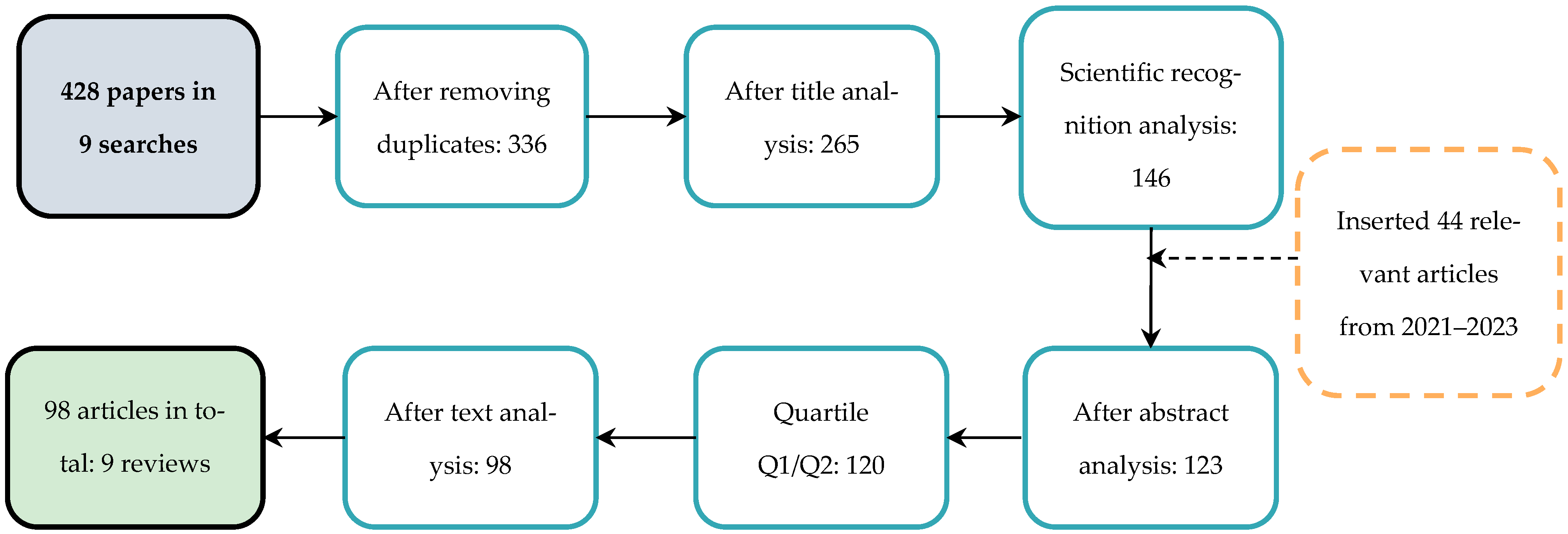

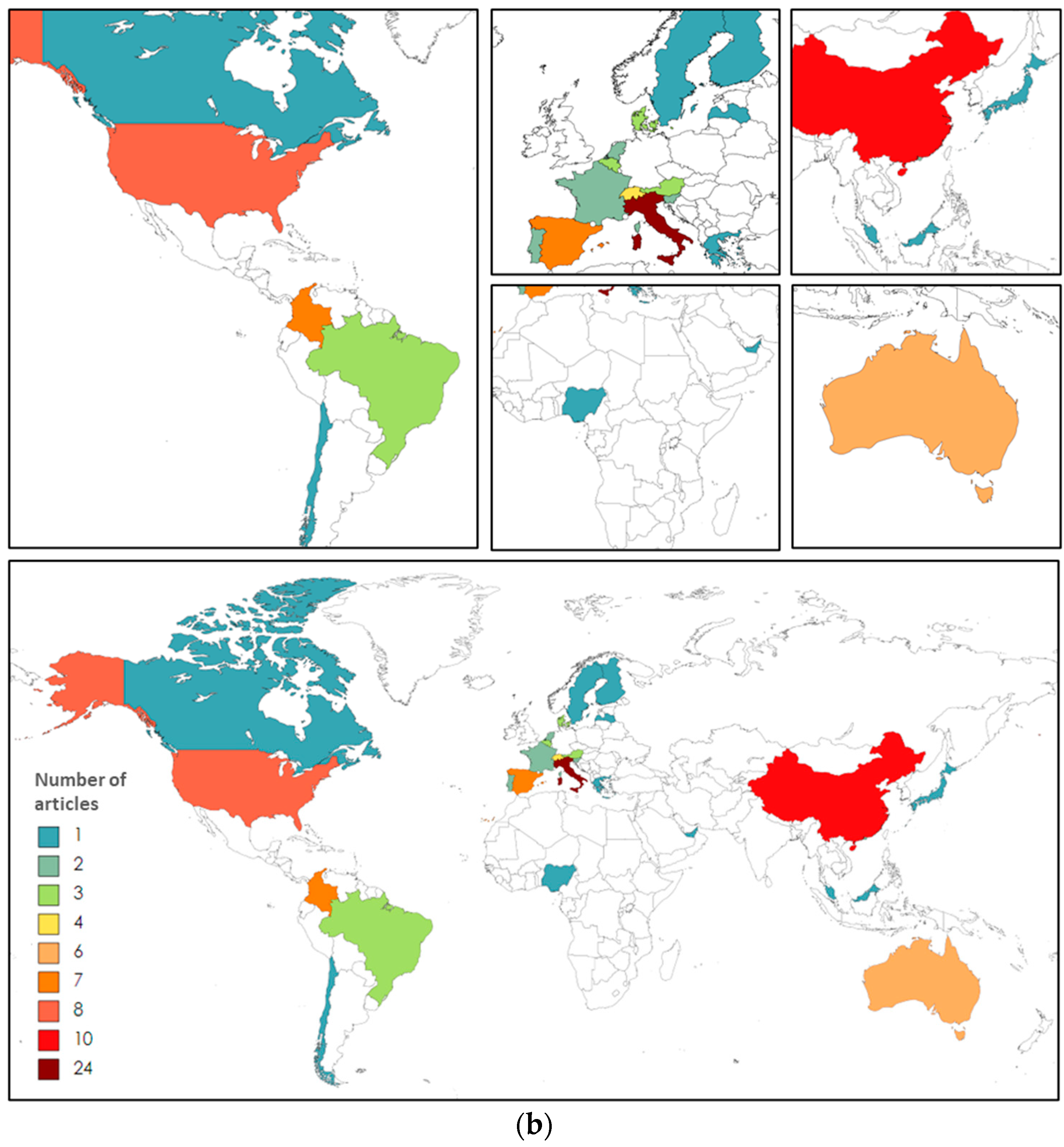
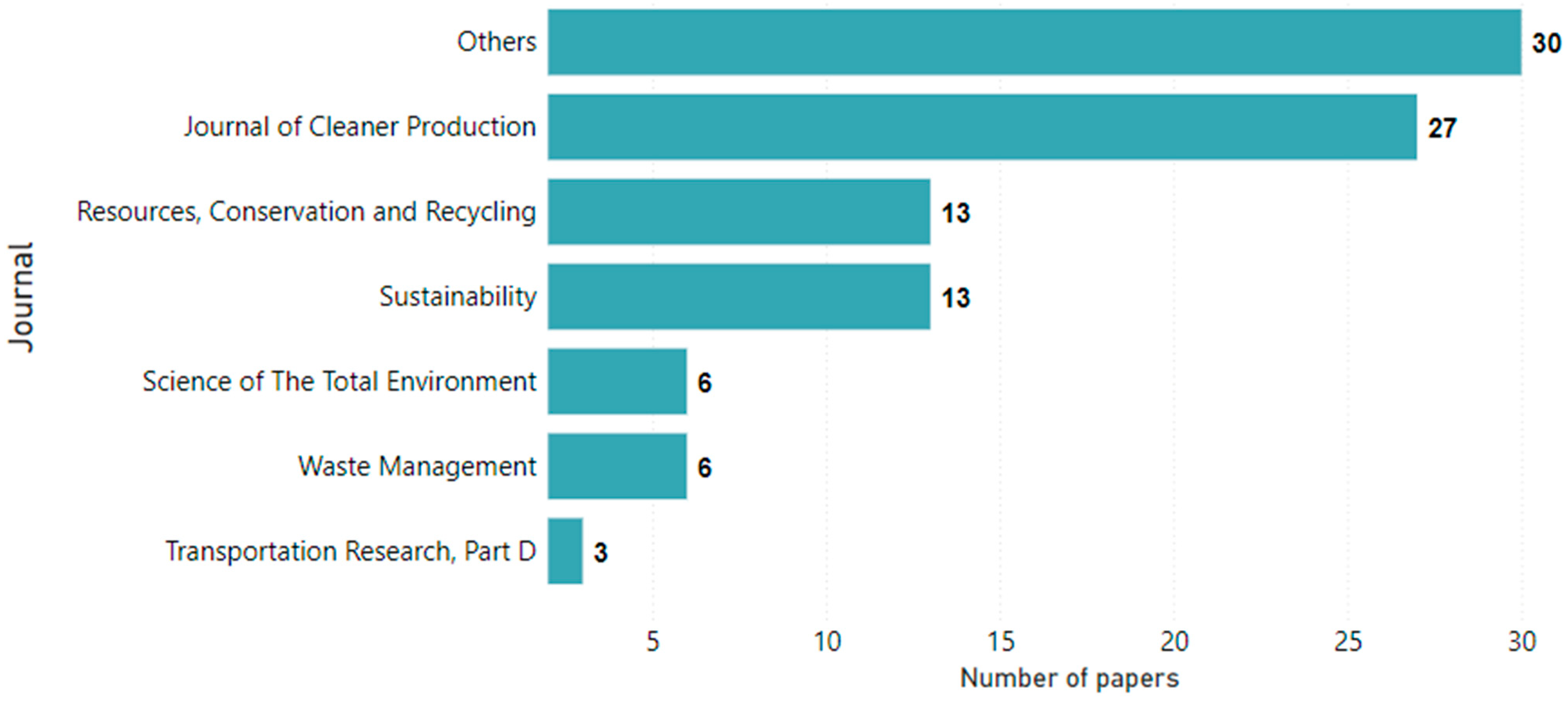
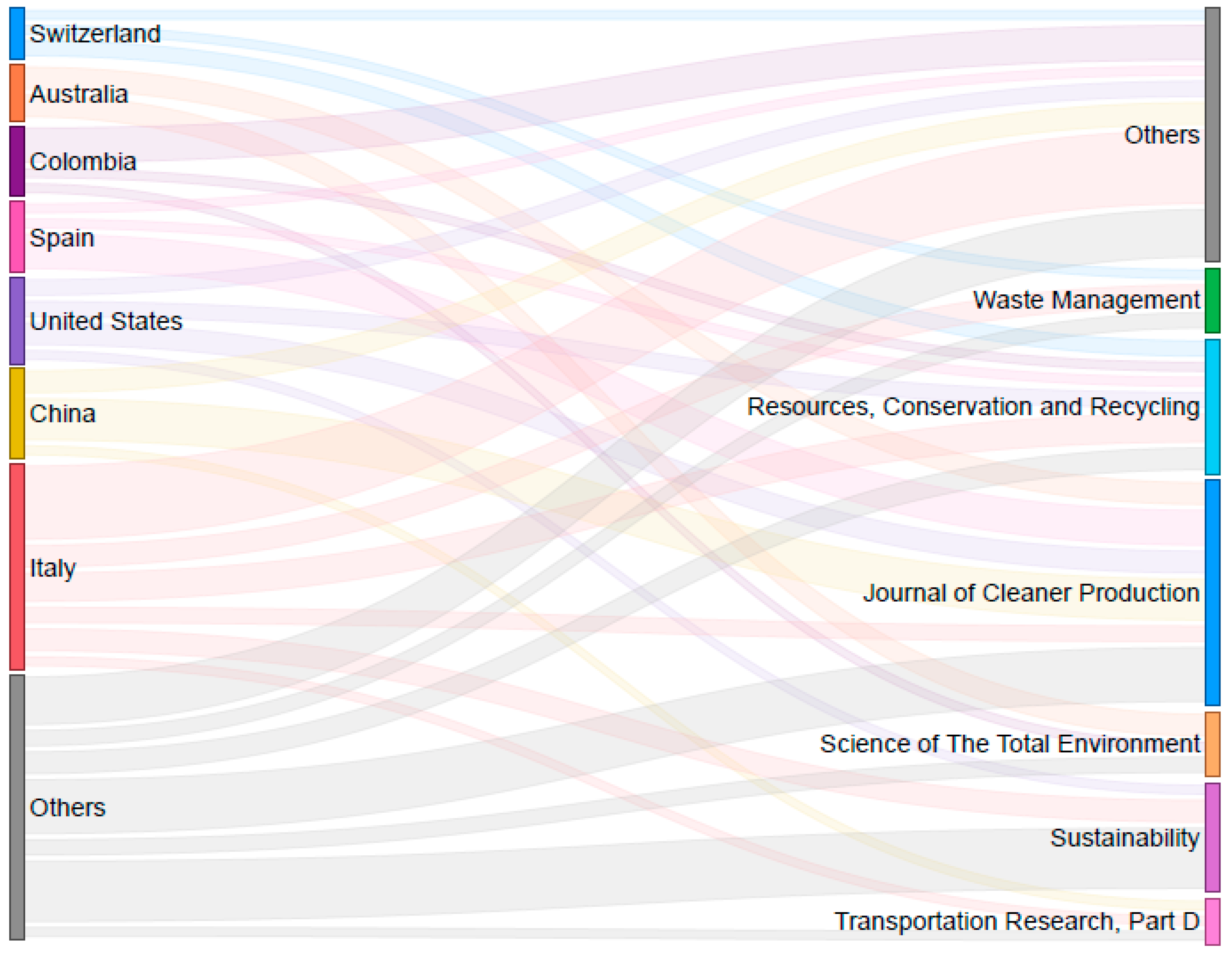

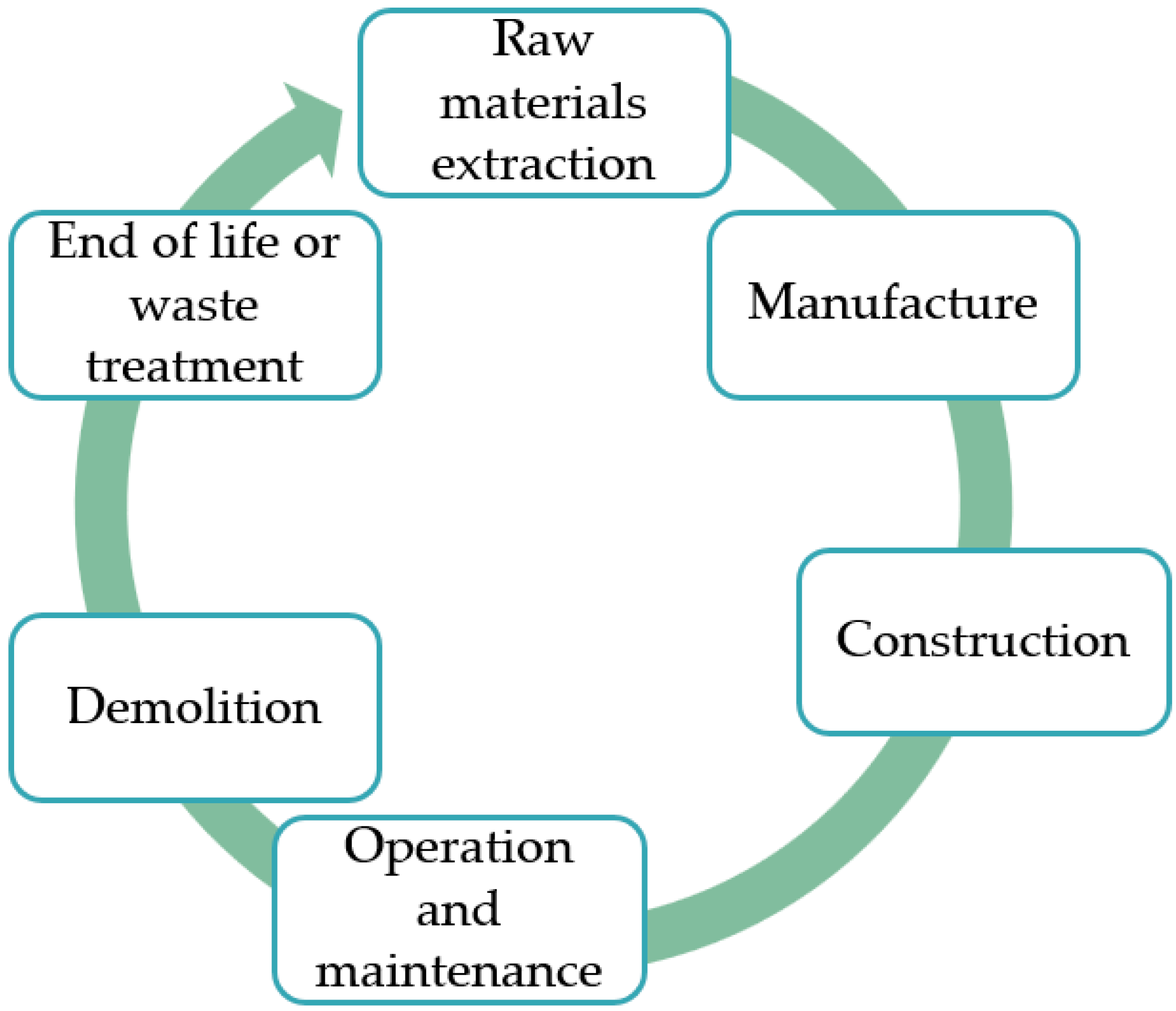
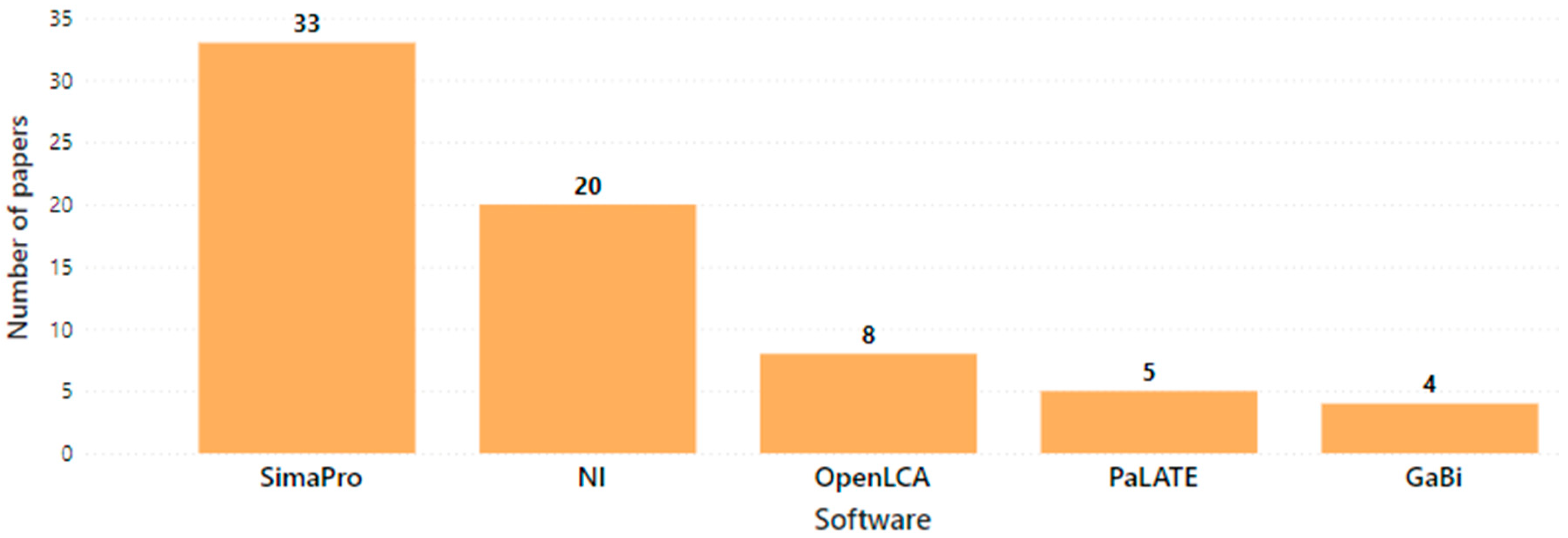
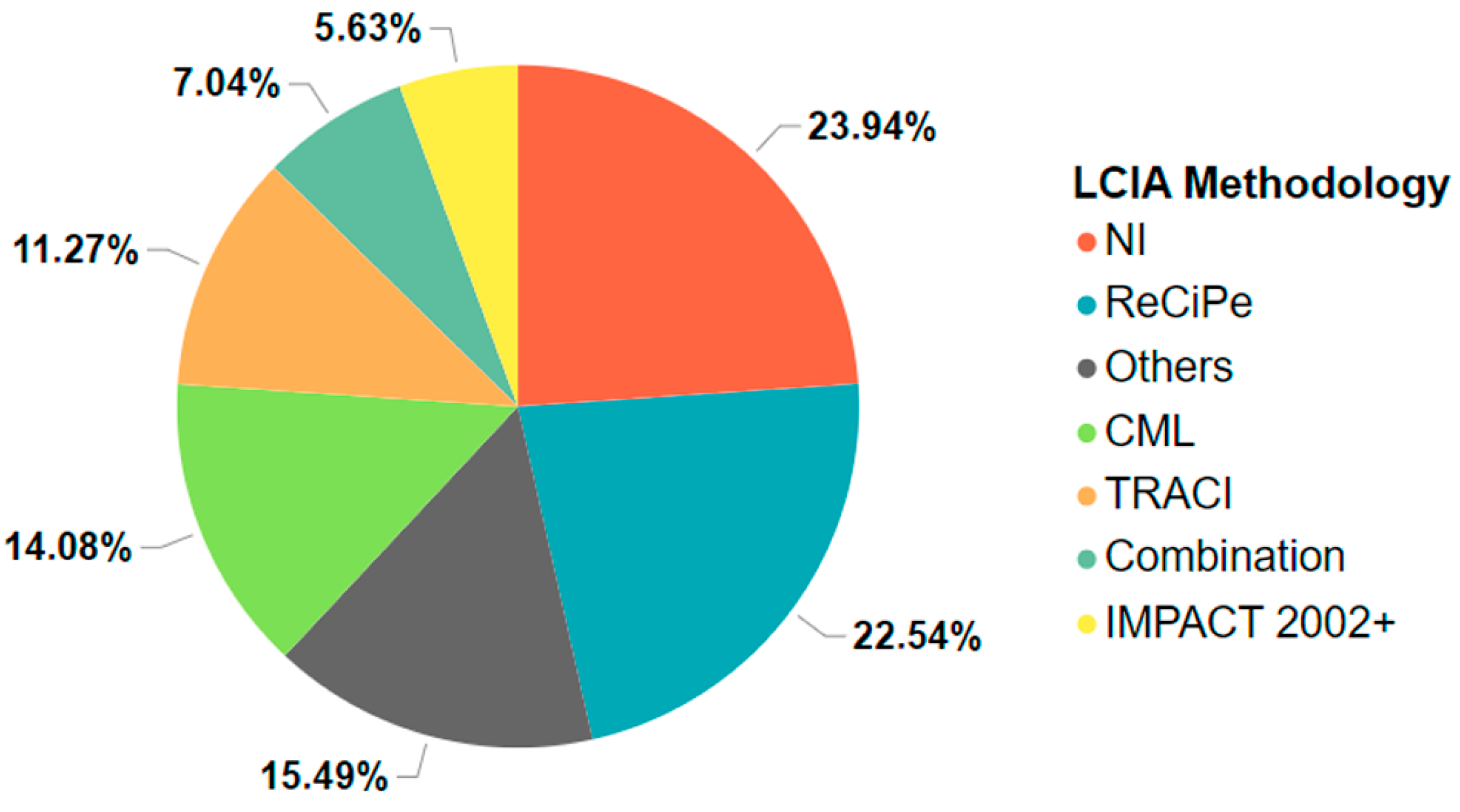



Disclaimer/Publisher’s Note: The statements, opinions and data contained in all publications are solely those of the individual author(s) and contributor(s) and not of MDPI and/or the editor(s). MDPI and/or the editor(s) disclaim responsibility for any injury to people or property resulting from any ideas, methods, instructions or products referred to in the content. |
© 2023 by the authors. Licensee MDPI, Basel, Switzerland. This article is an open access article distributed under the terms and conditions of the Creative Commons Attribution (CC BY) license (https://creativecommons.org/licenses/by/4.0/).
Share and Cite
Medina, T.; Calmon, J.L.; Vieira, D.; Bravo, A.; Vieira, T. Life Cycle Assessment of Road Pavements That Incorporate Waste Reuse: A Systematic Review and Guidelines Proposal. Sustainability 2023, 15, 14892. https://doi.org/10.3390/su152014892
Medina T, Calmon JL, Vieira D, Bravo A, Vieira T. Life Cycle Assessment of Road Pavements That Incorporate Waste Reuse: A Systematic Review and Guidelines Proposal. Sustainability. 2023; 15(20):14892. https://doi.org/10.3390/su152014892
Chicago/Turabian StyleMedina, Taísa, João Luiz Calmon, Darli Vieira, Alencar Bravo, and Thalya Vieira. 2023. "Life Cycle Assessment of Road Pavements That Incorporate Waste Reuse: A Systematic Review and Guidelines Proposal" Sustainability 15, no. 20: 14892. https://doi.org/10.3390/su152014892
APA StyleMedina, T., Calmon, J. L., Vieira, D., Bravo, A., & Vieira, T. (2023). Life Cycle Assessment of Road Pavements That Incorporate Waste Reuse: A Systematic Review and Guidelines Proposal. Sustainability, 15(20), 14892. https://doi.org/10.3390/su152014892






